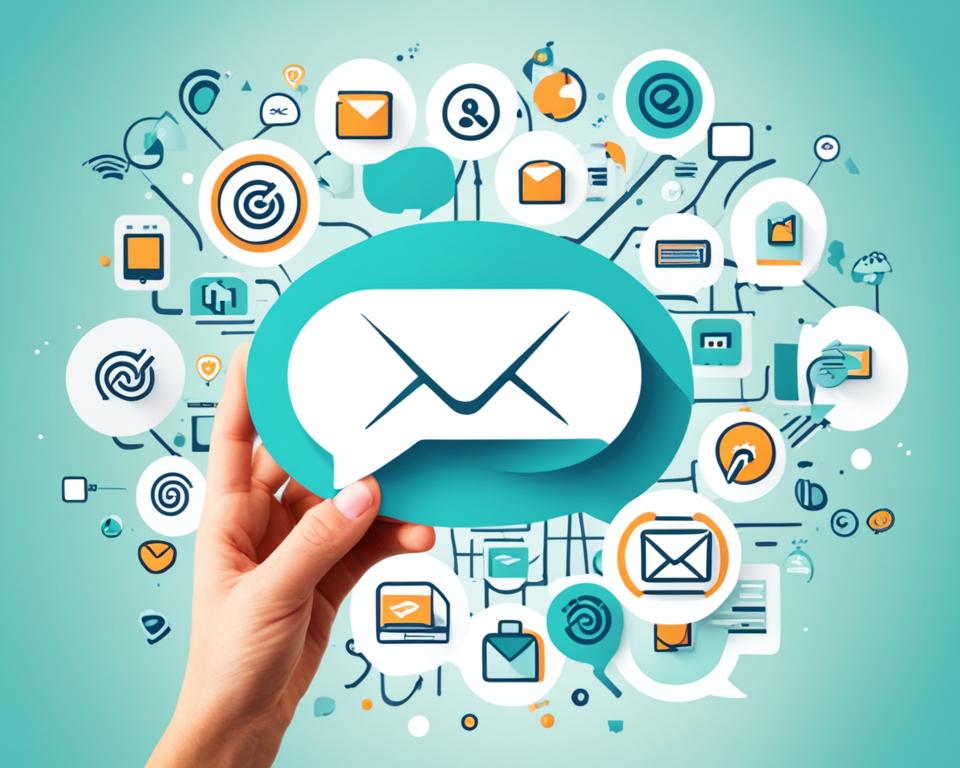Selamat datang di artikel kami yang membahas tentang meningkatkan respons dengan personalisasi dalam email marketing digital. Dalam dunia digital marketing yang semakin kompetitif, engagement menjadi kunci sukses dalam mencapai hasil yang optimal. Salah satu cara terbaik untuk meningkatkan engagement adalah melalui personalisasi konten email. Dalam artikel ini, kita akan menjelajahi strategi-strategi personalisasi yang efektif dalam digital marketing, khususnya dalam email marketing.
Personalisasi konten email merupakan sebuah pendekatan yang mengutamakan pengiriman pesan yang relevan dan menarik kepada penerima email. Dengan selalu mengedepankan kebutuhan dan preferensi individu, personalisasi konten email dapat meningkatkan kemungkinan respon dari penerima email. Hal ini karena personalisasi menciptakan koneksi emosional yang lebih kuat antara pengirim dan penerima, sehingga meningkatkan peluang untuk mencapai tujuan marketing yang diinginkan.
Di zaman yang serba cepat seperti sekarang, penerima email seringkali dibombardir dengan berbagai pesan promosi. Oleh karena itu, personalisasi konten email menjadi semakin penting untuk menonjol di antara tingginya persaingan. Dengan mengirimkan email yang terpersonalisasi, kita dapat membangun kepercayaan, meningkatkan minat, dan memotivasi penerima untuk mengambil tindakan yang diinginkan.
Dalam artikel ini, kita akan membahas kekuatan dari personalisasi dalam email marketing dan mengungkapkan praktik terbaik dalam membuat konten email yang terpersonalisasi. Kita juga akan menjelajahi bagaimana mengukur keberhasilan kampanye email yang terpersonalisasi dan sejauh mana peningkatan ini dapat diintegrasikan dengan strategi digital marketing lainnya. Mari kita mulai dan temukan bagaimana personalisasi dapat meningkatkan respons di dalam email marketing digital!
The Power of Personalization in Email Marketing
When it comes to email marketing, personalization holds immense power. By tailoring your emails to meet the unique preferences and needs of your recipients, you can capture their attention, increase open rates, and ultimately drive higher conversion rates. In fact, research shows that personalized emails generate six times higher transaction rates compared to generic emails.
One of the most effective ways to personalize your email content is by addressing recipients by their name. This simple yet impactful tactic can make your emails feel more personalized and establish a stronger connection with your audience. Additionally, segmenting your email lists based on customer preferences allows you to deliver highly targeted and relevant content, ensuring that each recipient receives information that resonates with their specific interests.
“Personalization is not just about adding someone’s name to an email. It’s about crafting a tailored experience that makes your recipients feel valued and understood.”
By addressing our customers by name and offering them content that aligns with their preferences, we have seen a significant increase in engagement and conversions. Personalization has become a vital component of our email marketing strategy, enabling us to build stronger relationships and deliver valuable experiences to our customers.
Benefits of Personalization in Email Marketing:
- Higher open rates: Personalized emails are more likely to be opened and read, leading to increased engagement with your brand.
- Improved click-through rates: When recipients receive emails that are tailored to their interests, they are more likely to click on the provided links and take the desired actions.
- Better conversion rates: Personalization creates a sense of relevance and trust, leading to higher conversion rates and improved ROI.
- Enhanced customer loyalty: By delivering personalized experiences, you can foster stronger connections with your customers and increase their loyalty to your brand.
Personalization in email marketing is a powerful tool that can take your digital marketing strategy to new heights. By leveraging the data you have about your customers and implementing effective personalization techniques, you can engage your audience on a deeper level and drive meaningful results.

| Personalization Statistics | Impact on Email Marketing |
|---|---|
| 74% of marketers believe that targeted email personalization increases customer engagement. | Personalization boosts customer engagement, leading to higher open rates and click-through rates. |
| Segmented email campaigns have a 14.31% higher open rate compared to non-segmented campaigns. | Segmenting your email lists allows you to deliver more relevant content, resulting in higher open rates and improved campaign performance. |
| 56% of consumers are more likely to purchase from a brand that recognizes them by name. | By addressing recipients by their name, you create a personalized experience that can drive customer loyalty and increase conversions. |
Best Practices for Creating Personalized Email Content
In the world of email marketing, personalized content is the key to capturing your audience’s attention and driving engagement. By tailoring your email content to individual preferences, you can create a more meaningful connection with your customers. In this section, we will explore the best practices for creating personalized email content that resonates with your audience.
- Leverage customer data: To better understand your audience’s preferences, utilize customer data that you have collected. This includes demographic information, past purchase history, and engagement metrics. By analyzing this data, you can gain insights into what types of content are most relevant to each customer segment.
- Design visually appealing emails: A visually appealing email is more likely to catch your recipient’s eye and encourage them to engage with your content. Use eye-catching images and graphics to enhance the visual appeal of your emails. However, make sure the images are optimized for quick loading and that they are accessible to all users, including those with visual impairments.
- Craft compelling subject lines: The subject line is the first impression your audience has of your email. Create subject lines that are concise, attention-grabbing, and personalized. Consider using the recipient’s name or referencing their past interactions with your brand to make the subject line more relevant and intriguing.
- Optimize email content for mobile devices: With the increasing use of smartphones, it is crucial to ensure that your email content is mobile-friendly. Optimize your email templates to display properly on different screen sizes and make sure that your call-to-action buttons and links are easily clickable on mobile devices.
The Power of Personalized Recommendations
In addition to the best practices mentioned above, personalized product recommendations can be an effective way to tailor your email content to individual customers. By analyzing purchase history and browsing behavior, you can recommend products that are most likely to interest each customer. This not only enhances the customer experience but also boosts the effectiveness of your email campaigns.
“Personalized email content has the power to create a deeper connection with your audience, leading to higher engagement and ultimately driving conversions. By following these best practices, you can maximize the impact of your email marketing efforts and achieve greater success.”
To illustrate the impact of personalization in email marketing, take a look at the example below:
| Email A | Email B |
|---|---|
| Generic subject line | Personalized subject line mentioning recipient’s name |
| No personalization | Content tailored to recipient’s past purchase history |
| Low engagement and conversion rates | Higher engagement and conversion rates |
As you can see from the example above, personalization can make a significant difference in the performance of your email campaigns. By implementing these best practices, you can create personalized email content that resonates with your audience, leading to higher engagement, increased conversions, and ultimately, business growth.

Measuring the Success of Personalized Email Campaigns
In today’s digital landscape, measuring the success of personalized email campaigns is vital for businesses to make informed decisions and enhance their marketing strategies. By analyzing key metrics and leveraging effective tools, businesses can gain valuable insights into the effectiveness of their email campaigns and drive continuous improvement. Let’s explore the essential metrics and tools that enable us to measure the success of personalized email campaigns.
Email Campaign Metrics
To measure the success of personalized email campaigns, several key metrics play a crucial role:
- Open Rates: The percentage of recipients who open the email.
- Click-through Rates: The percentage of recipients who click on links within the email.
- Conversion Rates: The percentage of recipients who complete a desired action, such as making a purchase or signing up for a newsletter, after clicking on a link in the email.
- Email Delivery Rates: The percentage of sent emails that successfully reach the recipient’s inbox.
By analyzing these metrics, businesses can gauge the engagement level of their personalized email campaigns and identify areas for improvement.
Email Marketing Analytics Tools
Tracking and analyzing the performance of personalized email campaigns require the use of reliable email marketing analytics tools. Here are some popular tools that provide valuable insights:
- Google Analytics: A comprehensive web analytics tool that allows businesses to track email campaign effectiveness, including conversion rates, page views, and user behavior.
- MailChimp: A popular email marketing platform that provides detailed campaign reports and analytics, including open rates, click-through rates, and subscriber engagement.
- HubSpot: An all-in-one marketing automation platform that offers robust email analytics, tracking email performance, lead nurturing, and customer engagement.
These tools enable businesses to measure the success of personalized email campaigns accurately and derive actionable insights for optimizing future campaigns.
| Metric | Definition |
|---|---|
| Open Rates | The percentage of recipients who open the email. |
| Click-through Rates | The percentage of recipients who click on links within the email. |
| Conversion Rates | The percentage of recipients who complete a desired action after clicking on a link in the email. |
| Email Delivery Rates | The percentage of sent emails that successfully reach the recipient’s inbox. |
Measuring the success of personalized email campaigns is not only about tracking metrics but also about making data-driven decisions. By analyzing the performance metrics and employing the right tools, businesses can understand the effectiveness of their email campaigns, identify successful tactics, and optimize their strategies to achieve better results.
Integrating Personalized Email Marketing with Other Digital Marketing Strategies
In today’s digital landscape, integration is key to maximizing the effectiveness of your marketing efforts. By seamlessly integrating personalized email marketing with other digital marketing strategies, businesses can enhance their reach, engage with their audience, and drive better results. Let’s explore how email marketing can complement a range of digital marketing strategies:
Email Marketing and Social Media Marketing
Social media platforms provide an excellent opportunity to expand the reach of your email marketing campaigns. By incorporating social sharing buttons in your emails, recipients can easily share your content with their social networks, increasing brand visibility and driving traffic to your website. Additionally, you can leverage social media platforms to grow your email subscriber base by promoting your email newsletters and exclusive offers to your social media followers.
Email Marketing and Search Engine Optimization (SEO)
Email marketing and SEO work hand in hand to improve your organic search rankings and increase website traffic. By including relevant keywords and compelling content in your emails, you can enhance your email deliverability and improve your chances of appearing in the top search results. Furthermore, linking back to your website in your emails helps drive traffic, which positively impacts your website’s SEO performance.
Email Marketing and Content Marketing
“Content is king.” – Bill Gates
Email marketing plays a vital role in content distribution and promotion. By including snippets of your latest blog posts, articles, or videos in your emails, you can provide value to your subscribers and direct them to consume more of your valuable content. This integration strengthens your content marketing strategy, drives traffic to your website, and builds a loyal audience that sees your brand as a trusted source of information.
Email Marketing and Pay-Per-Click (PPC) Advertising
Integrating email marketing with PPC advertising can maximize your return on investment (ROI) and drive targeted traffic to your website. By segmenting your email list based on customer behavior and preferences, you can create personalized PPC campaigns that resonate with specific audience segments. This integration enhances your ad relevance, improves conversion rates, and increases customer engagement.
Email Marketing and Mobile Marketing
In today’s mobile-first world, optimizing your emails for mobile devices is essential. By ensuring your emails are responsive and mobile-friendly, you can deliver a seamless and engaging experience to your subscribers across all devices. Additionally, leveraging SMS marketing and push notifications in conjunction with email can further enhance your mobile marketing efforts, allowing you to reach your audience wherever they are and deliver timely, personalized messages.
Integrating personalized email marketing with other digital marketing strategies amplifies your marketing effectiveness and drives better results. By leveraging the strengths of each strategy and creating a cohesive marketing ecosystem, businesses can maximize engagement, increase conversions, and build lasting relationships with their audience.
| Digital Marketing Strategy | How it Complements Email Marketing |
|---|---|
| Social Media Marketing | Expands reach, increases brand visibility, and grows email subscriber base |
| Search Engine Optimization (SEO) | Improves email deliverability and website traffic |
| Content Marketing | Distributes and promotes content, drives website traffic, and builds a loyal audience |
| Pay-Per-Click (PPC) Advertising | Enhances ad relevance, improves conversion rates, and increases customer engagement |
| Mobile Marketing | Delivers a seamless and engaging mobile experience, extends reach through SMS and push notifications |
Conclusion
In conclusion, personalization is a powerful strategy for enhancing engagement in email marketing and building stronger connections with customers in the broader context of digital marketing. By tailoring email content to individual preferences and needs, businesses can significantly increase open rates, click-through rates, and conversion rates.
Following best practices for creating personalized email content, such as leveraging customer data, designing visually appealing emails, and crafting compelling subject lines, can optimize the impact of email marketing efforts. Additionally, measuring the success of personalized email campaigns through key metrics and analytics tools provides valuable insights for improvement and better decision-making.
Integrating personalized email marketing with other digital marketing strategies, such as social media marketing, SEO, content marketing, PPC advertising, and mobile marketing, further enhances overall marketing effectiveness and drives better results.
In today’s competitive digital landscape, businesses must prioritize personalization in their email marketing strategy to stay ahead of the curve. By implementing the strategies and techniques discussed in this article, businesses can optimize their digital marketing efforts and achieve greater success in engaging and converting their target audience.
FAQ
What is digital marketing?
Digital marketing refers to the use of various online channels and strategies to promote products or services. It encompasses online advertising, social media marketing, search engine optimization (SEO), content marketing, pay-per-click (PPC), email marketing, web analytics, and mobile marketing.
What is the importance of personalized email content in digital marketing?
Personalized email content plays a crucial role in engaging customers and increasing response rates. By tailoring email content to individual preferences and needs, businesses can create a more personalized and relevant experience for recipients, leading to higher open rates, click-through rates, and conversions.
How can I personalize my email marketing campaigns?
There are several ways to personalize email marketing campaigns. You can address recipients by their names, segment your email lists based on customer preferences, customize content based on past interactions or purchases, and use dynamic content to display personalized recommendations or offers.
What are the best practices for creating personalized email content?
To create effective personalized email content, it is important to leverage customer data to understand individual preferences. Design visually appealing emails, craft compelling subject lines, personalize the email body, and optimize the email content for mobile devices. By following these best practices, you can maximize the impact of your email marketing efforts.
How do I measure the success of personalized email campaigns?
You can measure the success of personalized email campaigns by tracking key metrics such as open rates, click-through rates, conversion rates, and ROI. Utilize email marketing analytics tools to gain insights into campaign performance, identify trends, and make data-driven decisions for improvement.
Can personalized email marketing be integrated with other digital marketing strategies?
Absolutely! Personalized email marketing can be integrated with other digital marketing strategies such as social media marketing, SEO, content marketing, PPC advertising, and mobile marketing. By combining these strategies, businesses can create a cohesive and impactful marketing approach that enhances overall results.




